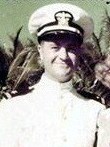CASKEY-JOHN
JOHN THOMAS CASKEY

LTJG

LOST AT SEA
On July 24, 1945, the USS UNDERHILL (DE-682), a Buckley class destroyer escort, was screening a convoy about 250-miles northeast of Cape Engano, Luzon, Philippines. The convoy consisted of a troop transport and six LST’s carrying remnants of the Army’s 96th Division, war-weary survivors going to the Philippines for much deserved rest and reinforcements. During the morning a Japanese bomber was observed circling the convoy about 10-miles away and out of range of the UNDERHILL’s guns. Although Japanese submarines were believed to be in the area they were not detected by the UNDERHILL’s crew and after about 45-minutes the circling plane departed. Shortly thereafter a lookout spotted a mine floating in the path of the convoy causing the convoy to change course. After repeated direct hits from UNDERHILL’s guns, the mine was determined to be a “dummy” purposely placed in the convoy’s path.
Unbeknown to UNDERHILL, two Japanese submarines each carrying four Kaiten midget manned suicide submarines on their decks, were nearby. The Kaitens were about 35-feet long, carried the equivalent explosive charge of two torpedoes and could not be retrieved once they were released from the submarine’s deck. Shortly after leaving the “dummy” mine behind, a Japanese submarine was observed on the surface so UNDERHILL rapidly headed for the quickly submerging contact. Upon reaching the area UNDERHILL dropped a 13-charge pattern of depth charges on the submerging submarine. The depth charges brought to the surface debris and two Kaitens. One was too close in range for UNDERHILL’s guns to bear on it and the captain ordered all hands to “stand by for a ram” of the other Kaiten. Ordering flank speed, UNDERHILL rammed the port side of Kaiten and after a few seconds there were two explosions, one directly under the UNDERHILL bridge and magazine area, and the second one forward of the bridge. The explosions ripped UNDERHILL apart, leaving the forward part of the ship sticking straight up and the stern section floating away.
There was no panic among surviving crew members, a fire in the crew’s mess was extinguished by the damage control crew and remaining serviceable guns were manned by walking wounded in case Japanese subs surfaced. Life rafts were jettisoned as lifeboats to pick up men blown over the side. A total of 112 crew members perished in the blast and 122 survived. The USS UNDERHILL was the last destroyer escort lost during World War II.
There were 14 officers aboard UNDERHILL, ten of whom died in the sinking including LTJG John Thomas Caskey. He was reportedly born on February 13, 1917, in Marietta, Ohio, and grew up in Washington, D.C. Little has been recorded concerning him in addition to the fact that his body was not recovered after the UNDERHILL’s sinking and he was survived by his wife, Jane Kelley Smith. LTJG Caskey’s name is inscribed on the Tablets of the Missing at the American Cemetery and Memorial in Manila, Philippines. In addition a memorial marker in his honor has been placed in Cedar Hill Cemetery in Suitland, Maryland.
Submitted by CDR Roy A. Mosteller, USNR (Ret)

